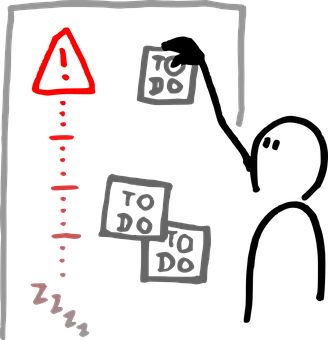The technique of assigning relative importance to various aspects of a set of things is known as prioritization. It is necessary in product planning to assign a priority ranking to each of the projects that are stored in the backlog in order to determine what should be created next.
In product designing and development, MoSCoW prioritization method is one of the most commonly used methods because it is the simplest and most practical to determine the right software development lifecycle to make your team most productive.
What is MoSCoW Prioritization?
The MoSCoW technique is a four-step process for determining which aspects of a project deserve the highest priority in order to get the greatest benefit (ROI). The o’s in MoSCoW were added so that the abbreviation would be easier to say. MoSCoW is an acronym that stands for must have, should have, could have, and will not have.

The MoSCoW approach is utilized in a wide range of different company specializations. It makes it possible for everyone working on a project to be aware of what tasks need to be accomplished first and how completing those tasks will contribute to the project’s goals of increasing revenue, reducing operating costs, improving productivity, or boosting customer happiness.
When it comes to the business side of things, it can assist stakeholders frame talks about the value of particular product characteristics when selecting a software provider. The MoSCoW technique plays a significant part in Agile project management on the information technology (IT) side by assisting project teams in prioritizing story points.
In addition, putting needs in order of importance allows project teams to have a better understanding of the amount of time and resources that will be necessary for each component of the project. With this information, the team will be able to better manage their time and projects. In addition, it increases the chances of finishing tasks before deadlines and maximizes return on investment.
When working on a DSDM project with a predetermined amount of time, it is essential to have a solid understanding of the relative significance of the work that has to be completed in order to make headway and meet deadlines. Prioritization may be applied to a variety of different things, including demands, tasks, products, use scenarios, assessment criteria, and tests; however, requirements/User Stories are the areas in which it is used most frequently. A particularly effective method of creating requirements in an agile manner is to use user stories.
By outlining distinct criteria for each degree of importance, MoSCoW prioritization is able to evade one of the most significant challenges presented by less sophisticated prioritizing methods.
The use of a straightforward high, medium, or low categorization is less effective due to the absence of definitions for these priorities or the necessity of their definitions. This classification does not in any way give the company a clear indication of what to anticipate in the future. A classification system that just offers one option in the center, such as “medium,” leaves room for uncertainty.
The use of a straightforward sequential priority, such as 1, 2, 3, 4, etc., is less powerful since it manages items of comparable significance in a less efficient manner. There is a possibility of lengthy and intense debates on whether or not an item should be positioned one spot higher or lower.
This item and the expectations for its completion are made abundantly plain by the particular use of the phrases “Must Have,” “Should Have,” “Could Have,” and “Won’t Have” at this time.
Additional Reading: What Are The Major Advantages & Disadvantages of NoSQL?
Background
In 1994, Dai Clegg provided Oracle with consultancy services related to software development. Teams were adopting RAD which stands for, Rapid Application Development, but they had limited time, which motivated Dai Clegg to establish the MoSCoW rule to assist prioritize development work during product releases.

In the early 2000s, the rule known as MoSCoW gained widespread acceptance within the agile project delivery framework known as DSDM (Dynamic Systems Development Method). DSDM is an initiative that aims to enhance RAD development.
Fixing the criteria for cost, quality, and timing at the very beginning of the project is one such technique. This is crucial. MoSCoW is an appropriate solution.
The usefulness of the MoSCoW principles for decision-making has become more obvious as the agile methodology has gained favor. Within the context of the agile framework, the MoSCoW approach of prioritization is currently seeing widespread use.
Read More About: CTO vs CEO–Who Is Responsible For Business Growth?
MoSCoW Prioritization: What are the best practices?
Here are a few measures to keep in mind if you’re thinking about giving MoSCoW prioritizing a go in your organization. If your team is using the MoSCoW technique, including these in your process can help your group get more value out of it.

1. Decide How to Number Each Category
MoSCoW assists your team in categorizing products into the proper groups, ranging from items that are an absolute must to items that may be added to a wish list for the future. However, MoSCoW by itself does not provide any assistance in determining which items should be placed in which categories.
You will need to come up with your own method of ranking. You have several options to pick from, including the following:
- The use of weighted scoring
- Value vs. sophistication
- Kano method
- Acquire
- Opportunity evaluation and scoring
2. Make Your MoSCoW Process More Organized
You may be able to develop support for your work throughout the whole organization using this strategy, or at the very least, it may assist you in demonstrating to stakeholders why you made the choices that you did in this situation.
Your team now has a concrete approach to demonstrate to your company which activities should be prioritized for your products or projects thanks to MoSCoW.
Read More About: A Detailed Guide on Fractional CTO services in 2022
When you communicate the priority plan of your team to the rest of the organization, it helps you set expectations for everyone. Stakeholders in other departments will realize that your team has carefully considered and balanced all of the decisions you’ve made once they see your approach for picking one campaign over another and when they observe how you arrived at that conclusion.
If any of the stakeholders in the project have a problem with one of your choices, they will be aware that they cannot just complain; rather, they will be required to give you proof in order to change your plan of action.
3. Involve All of Your Important Stakeholders in the Process
Your team requires context to ensure that each project is placed in the appropriate bucket—must-have, should-have, could-have, or won’t-have.
As part of your MoSCoW process, your team should assess which stakeholders can contribute useful context and insights. Sales?
Is it possible to achieve customer satisfaction?
Is this referring to the top levels of management?
Is there a product manager in another part of your company?
If you believe they can assist you in identifying potential possibilities or risks that your team may have overlooked, consider including them in your initiative scoring process.
How Does MoSCoW Prioritization Work?
Certain steps must be taken prior to conducting a MoSCoW analysis. First, key stakeholders and the product team need to be on the same page about the goals and priorities of the project. The next step is for everyone to agree on which objectives should be given top priority.
Your team should also talk about how to resolve differences over priority settings at this time. You may assist keep development from being slowed down by figuring out how to handle arguments before they arise.
Finally, it’s important to agree on the percentage of resources that should be allocated to each of the categories.
You may now begin the process of deciding which category is best suited for you.
Categories of MoSCoW Prioritization

1- Must-Have.
This category contains activities for your team that are considered “musts,” as the name of the category indicates. They indicate requirements for the project, product, or release in an issue that cannot be negotiated away. For instance, if you are going to release an application for the healthcare industry, one of the must-have initiatives may be security functions that assist in the upkeep of compliance.
In order for the team to earn credit for the “must-have” category, they are required to carry out an essential step. They can be defined by:
- Without this, there is no sense in delivering on the target date; similarly, there would be no value in deploying the solution on the planned date if it were not provided.
- Risky in the absence of it
- Without it, we are unable to provide a solution that is viable.
Read More About: Various Types of Website Designs and Their Primary Functions
2- Should-Have.
The projects that should be pursued are only one level below the must-haves. They are not absolutely necessary for the completion of the product, project, or release; nonetheless, their presence is highly recommended. The functionality of the product or project is not affected if anything is omitted. Nevertheless, the projects may provide a substantial amount of value.
The distinction between “should-have” efforts and “must-have” initiatives lies in the fact that the former can be put on the schedule for a subsequent release without having an effect on the latter. Initiatives that “should have” been done, for instance, include performance enhancements, minor bug repairs, and the addition of new features. The product is still functional even without them. They can be defined as:
- Not critical, but still important.
- It might be difficult to exclude, but a solution is still a workable option.
- Possible requirements include the managing of expectations, the acceptance of some level of inefficiency, the use of an existing solution, documentation, and so on. It’s possible that the workaround is only a temporary solution.
3- Could-Have.
Nice-to-have initiatives are another term that may be used to refer to “could-have” actions. Initiatives that “could-have” been taken are not essential to the primary operation of the product. However, in comparison to other projects that “should have been done,” their absence has a considerably less significant bearing on the final result.
Therefore, projects that were assigned to the “could have” category are frequently the first ones to lose their priority if a project that was assigned to the “should have” or “must-have” category turns out to be more extensive than anticipated.
- Desirable, yet of secondary importance
- Less effect compared to should have if left out
4- Won’t Have.
One of the advantages of using the MoSCoW technique is that it automatically assigns several projects to the “will not have” category. It is possible for the category to manage expectations on what the team will not add in a certain release (or another period that you are prioritizing).
One strategy that may be utilized to assist in the prevention of scope creep is to place efforts in the category of “will not have.” If an effort falls into this category, the team is aware that it is not a priority for the time that is being considered.
The “will-not-have” group contains a number of efforts, some of which will be emphasized in the future while others are highly unlikely to occur. Some of the teams have come to the conclusion that the best way to separate themselves from others is to establish a subcategory inside this larger group.
Read More About: A Step By Step Guide To MVP Development
How Development Teams Can Use Moscow Prioritization Method?
Although this method was devised to assist in prioritizing activities around the constrained amount of time that teams had available, the MoSCoW method is useful even when development teams are faced with limits other than time. Take, for instance:
1. Prioritize Skill Sets
It’s possible that a cross-functional team may find that the experience and knowledge of its developers place a limit on what they can do. This limiting factor will be taken into consideration when the team is ranking those items in their MoSCoW analysis if the product roadmap asks for features that the team does not have the capabilities to create.
2. Budget-Based Priorities
What happens if the constraining factor for a development team is not a timetable but rather a strict budget that the corporation requires?
MoSCoW may be used by the team, in conjunction with the product managers, to determine which efforts constitute must-haves and which represent should-haves as the first step in the process. The group will then be able to determine which tasks they are able to carry out by consulting the financial plan for the department of development.
3. Prioritize corporate needs
It is possible for cross-functional teams to run across roadblocks caused by different goals inside the firm. The group is eager to make headway on a new product release; however, the executive staff has set stringent timelines for further product releases to be completed within the same timeframe. In this scenario, the team may utilize MoSCoW to evaluate which components of their targeted release represent must-haves and temporarily backlog anything else that is not one of the must-haves.
Benefits of using the MoSCoW technique
Dividing the tasks of your team into categories according to their importance during the development can have many advantages in planning the sprints and a map of how to build the application in the most efficient way. MoSCoW prioritization can have the following benefits:
1. Speed
When you have several must-have initiatives and don’t know what order to follow during development, you’ll have to run several rounds of prioritization. It can make you slow.
This method allows speed and efficiency.
2. Efficiency
Development with more efficiency and speed saves time thus cutting down costs by reducing development time.
3. Smaller more Achievable Tasks
If a sprint solely includes “must-have” tasks, there is a slim probability that it will be completed successfully. Because must-haves are often needs that are more difficult and serve to ensure the sustainability of a product, the process of implementing them requires a greater investment of time and focus on the part of a developer. You can add some S0, C0, or S1 activities to the sprint in order to dilute high-importance work with some low-hanging jobs. This will ensure that consumers receive somewhat more comprehensive functionality of the primary Must-have processes.
4. Better Features
Should and could have initiatives help create a more pleasant product for users because they represent extra features or premium feel to the product.
Read More About: 14 Tips For Choosing A Web Design Company in 2022
Drawbacks of MoSCoW Prioritization
Even while many design/development teams have made MoSCoW a priority method, there are possible problems associated with the method. The following are some examples:
1. Unreliable scoring can misclassify jobs
One of the most prevalent complaints leveled against MoSCoW is that it does not provide a technique that is objective for evaluating different projects against one another. This technique is going to be necessary for the analysis that your team is doing. The only way for the MoSCoW method to be effective is to guarantee that your team will use a uniform score system for all of the initiatives.
A tried and true technique is called weighted scoring, and it entails your team evaluating each endeavor in your backlog by comparing it to a standard set of cost and benefit criteria. In the road map app provided by ProductPlan, you have the option to apply the weighted scoring method.
2. Team prejudice can impede MoSCoW’s efficacy
MoSCoW does not offer an objective grading mechanism, the members of your team are susceptible to being swayed by their own viewpoints towards particular activities.
One of the potential drawbacks of utilizing MoSCoW to determine priorities is the possibility that a group would erroneously believe that MoSCoW itself is an objective means of evaluating the things on their list.
They discuss a proposal, come to the conclusion that it is a “should have,” and then go on to the following one.
However, your team will also want a framework that is objective and consistent in order to rate all of the efforts. This is the only method to reduce the amount of prejudice that your team has in favor of or against particular products.
3. Not including all stakeholders might lead to miscategorized things
You will need as much information as you can get your hands on in order to determine which of the efforts that your team is working on constitute must-haves for your product and which are just should-haves.
For instance, you could require a member of your sales staff to provide feedback about the perceived significance (or lack thereof) of a proposed new feature from potential customers.
If your team does not get feedback from all of the essential stakeholders, you run the risk of making bad judgments on where to slot each initiative when using the MoSCoW technique. This is one of the system’s potential pitfalls.
Read More About: A Detailed Guide to the Types of Software
Summing up
Although MoSCoW (Must Have, Should Have, Could Have, Will not Have) is typically used to prioritize needs, the concept is applicable in a great number of other areas as well. The DSDM methodology suggests allocating no more than 60 percent of the whole project work to Must-Have needs and maintaining a reasonable pool of Could-Haves, which typically takes up around 20 percent of the total project effort. If the environment and any technology are not well known, the team is not well established, and the external risks are not small, then anything above sixty percent of the work must be considered a have and poses a danger to the success and predictability of the project.
Interested in how the MoSCoW method can help us plan your next project? Hit us up for more information.
FAQs
What exactly is the MoSCoW strategy for prioritization?
Prioritization based on the MoSCoW model, which is also known as the MoSCoW approach or MoSCoW analysis, is a strategy that is commonly used for the management of needs. The abbreviation MoSCoW refers to four distinct types of initiatives: those that are a must-have, those that should have been done, those that could have been done, and those that will not be done at this time.
What does the acronym MoSCoW stand for?
The o’s in MoSCoW were added so that the abbreviation would be easier to say. MoSCoW is an acronym that stands for must have, should have, could have, and will not have. The MoSCoW approach is utilized in a wide range of different company specializations.
What exactly does MoSCoW imply when it comes to agile?
Although MoSCoW (Must Have, Should Have, Could Have, Will not Have) is typically used to prioritize needs, the concept is applicable in a great number of other areas as well.
Is the backlog a top priority for MoSCoW?
The Product Owner is the one who is in charge of preparing the Product Backlog and assigning priorities to the things that are included in the Product Backlog.




